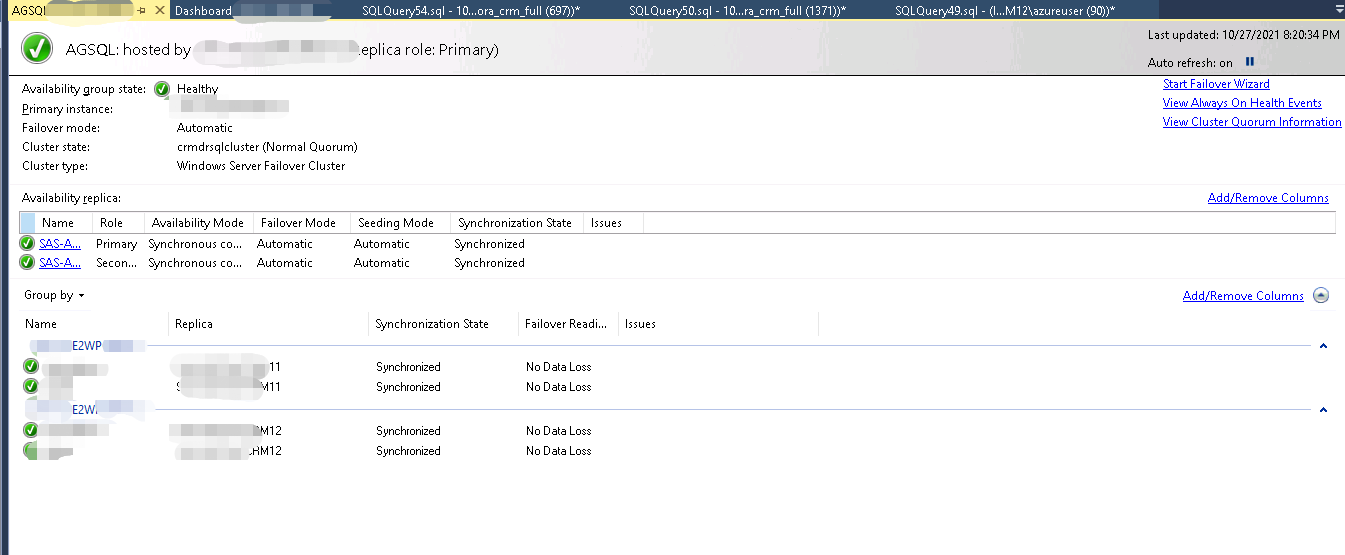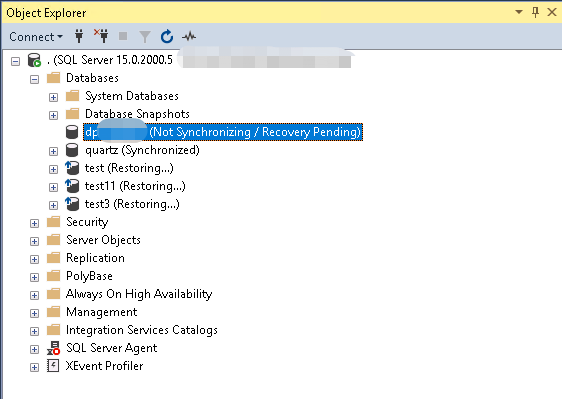SQL Server ->> AlwaysOn 监控脚本
第一条是监控主节点和副本的健康状况,还有配置信息
1、primary_recovery_health_desc , secondary_recovery_health_desc 主要展示相关的服务是否在线
2、synchronization_health_desc 当前同步的状态
3、recovery_health_desc 判断当前同步组中的所有数据库是否都在同步中,如果展示为 ONLINE_IN_PROGRESS, 则说明在复制组中的某个数据库不在同步状态, 如果展示为 PROGRESS ,则说明在这个同步组中的所有数据库均在正常同步状态
大致上面的脚本是这样。
最后在说一下 RTO
Estimating failover time (RTO), 这个名词,其实就是要评估一下,如果我们的集群中的primary 失败,我们需要多长的时间进行failover
一个 failover 主要需要的时间是有以下几点组成的
主机失败的诊断和决策时间,进行数据的redo时间,以及最后的切换时间
SELECT ag.name AS 'GroupName' ,cs.replica_server_name AS 'Replica' ,rs.role_desc AS 'Role' ,ag.health_check_timeout as health_check_timeout_ms ,case ag.failure_condition_level when 1 then 'service down' when 2 then 'the server is out of control' when 3 then 'default value,or spin lock' when 4 then 'Please check your memory resource' when 5 then 'automatic failover' end as failure_condition_level ,REPLACE(ar.availability_mode_desc,'_',' ') AS 'AvailabilityMode' ,ags.primary_recovery_health_desc ,ags.secondary_recovery_health_desc ,ar.failover_mode_desc AS 'FailoverMode' ,rs.recovery_health_desc ,rs.synchronization_health_desc ,ar.seeding_mode_desc AS 'SeedingMode' ,ar.endpoint_url AS 'EndpointURL' ,al.dns_name AS 'Listener' FROM sys.availability_groups ag JOIN sys.dm_hadr_availability_group_states ags ON ag.group_id = ags.group_id JOIN sys.dm_hadr_availability_replica_cluster_states cs ON ags.group_id = cs.group_id JOIN sys.availability_replicas ar ON ar.replica_id = cs.replica_id JOIN sys.dm_hadr_availability_replica_states rs ON rs.replica_id = cs.replica_id LEFT JOIN sys.availability_group_listeners al ON ar.group_id = al.group_id
下面这条脚本是看目前副本有多少日志还没有redo,redo_rate_in_mb是平均每秒的redo日志量,Tredo/M是预估大概还有多少分钟redo完。但是有一点,日志是在不断增加的,首先redo的速度是要大于日志新增的数据,不然不可能redo完。
redo_queue_size(KB/S),redo_rate secondary节点上做REDO的速率(KB/S)
SELECT ag.name AS 'GroupName' ,db_name(hst.database_id) as dbname ,cs.replica_server_name AS 'Replica' ,ag.health_check_timeout as health_check_timeout_ms ,cast(hst.redo_queue_size as float) / 1024 as redo_queue_size_in_mb
,hst.redo_rate/1024 as redo_rate_in_mb ,cast(hst.redo_queue_size as float) / hst.redo_rate as [Tredo/S] ,cast(hst.redo_queue_size as float) / hst.redo_rate / 60 as [Tredo/M] ,ags.primary_recovery_health_desc ,ags.secondary_recovery_health_desc ,ar.failover_mode_desc AS 'FailoverMode' FROM sys.availability_groups ag JOIN sys.dm_hadr_availability_group_states ags ON ag.group_id = ags.group_id JOIN sys.dm_hadr_availability_replica_cluster_states cs ON ags.group_id = cs.group_id Join sys.dm_hadr_database_replica_states as hst on ags.group_id = hst.group_id JOIN sys.availability_replicas ar ON ar.replica_id = cs.replica_id where hst.database_id = db_id('dbxxxxx') and ar.replica_metadata_id is not null and ags.primary_recovery_health is null
通过仪表板是比较直观的,但是这里看到Synchronized状态不代表数据就是同步了,这里只是告诉你,主节点的日志可以正常同步到副本,至于redo的延迟是不管的。所以只能说明连通性是ok的。

如果看到数据库处于Not Synchronizing的状态,说明高可用副本同步中断了。




【推荐】编程新体验,更懂你的AI,立即体验豆包MarsCode编程助手
【推荐】凌霞软件回馈社区,博客园 & 1Panel & Halo 联合会员上线
【推荐】抖音旗下AI助手豆包,你的智能百科全书,全免费不限次数
【推荐】轻量又高性能的 SSH 工具 IShell:AI 加持,快人一步